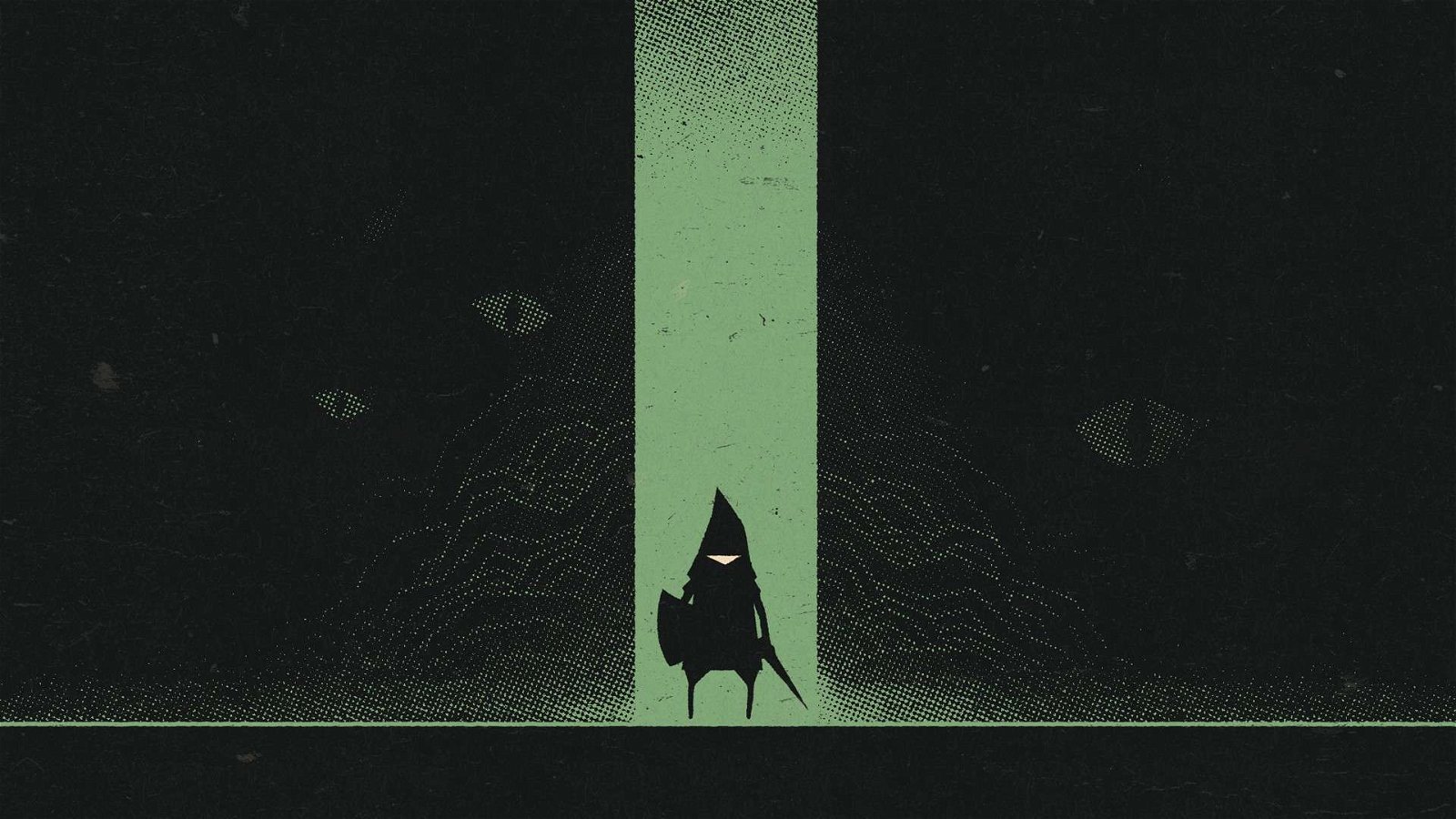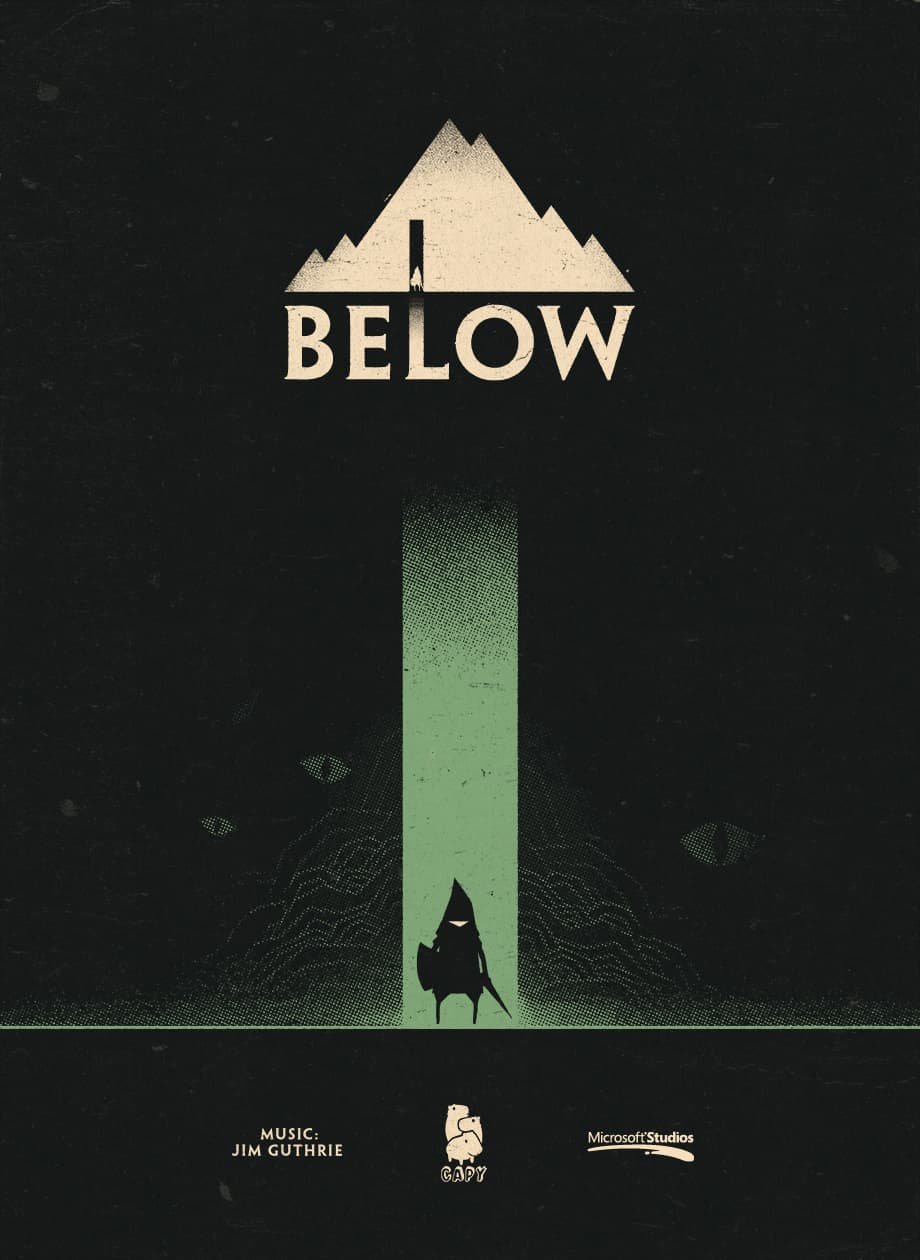The opening track to Jim Guthrie’s soundtrack for Capybara’s Below is titled “Moth to a Flame;” an apt introduction to the game’s central premise. After nearly twenty hours, I cannot say what it is that pulls me to this game. It is unforgiving, even unfair at times. Its tight, minimalist combat and crafting design is rewarding on its own accord, but not so much as to warrant for the brutality of its survival mechanics and, most unforgivably, its unhelpful checkpoint system. There’s no discernible story told in Below, no addicting gameplay loop, no rewarding carrot on a stick to trick me into chasing down its endgame. The game tells me at every turn that it is indifferent to my wants, my efforts, and my expectations. The more I raged at the injustices or inadequacies Below presented, the more I realized it doesn’t give a damn about the player. I’m not sure, but I believe this, above all else, kept me coming back to the game.
In Below, you’ll play as nameless adventurers as they venture the infinite depths of a mysterious cave, one filled with monsters, traps, and an impossible variety of biomes. Equipped with little more than sword and shield, you are given no explicit task, but are rather drawn downwards to fight your way towards whatever lies at the indiscernible bottom of this dreadful pit. Through your descent, you will lead many of these adventurers to their death, making use of their final resting place as a stepping stone for your progress; as in other roguelikes, each time your character dies, another spawns at the start of the cave and must make their way towards the last to retrieve the valuables left by the corpse of your last run. Once the pains of having to start anew have abated, you’ll care very little for the fates of your little adventurers. The game cares even less.

The moment-to-moment action of Below plays much like a 2D game from Nintendo’s The Legend of Zelda series; from a top-down perspective, you control a miniature warrior as you hack and slash through various monsters, searching for keys to doors that lead further downwards. Some enemies can easily be bested with simple sword attacks, while others might be best approached from afar with bow and arrow. The weak and most pervasive mobs will fall to single jabs from your choice of melee weapon, while other, more sophisticated enemies might require a tactical approach; you’ll find rhythms for dodging past slow shield-wielding enemies to find an opening, or you’ll take an aggressive sprint to land a powerful jumping attack before they sense your presence. You can always make use of fire arrows and bombs to gain the advantage, but when resources are low, sword and shield are your bread and butter.
The combat is of a familiar recipe from the action-adventure oeuvre, and it’s complemented by tight survival and crafting systems. Defeated monsters may leave behind morsels of food to abate your hunger meter, bundles of string for crafting torches and arrows, or even blood moss and slime that can be used (somehow) to make bandages. The system is simple and minimalist, though completely unexplained and left to your experimentation. While resting at a checkpoint fire pit (a la Dark Souls), you may choose three items in your inventory to combine and make something new. Simple recipes like three sticks will make a bundle of wood, while more complex concoctions like a bundle, a crystal, and a weave of strings will yield a magic rod. With only sixteen slots available in your inventory, experimentation is always simple and easy to get your head around.

Inventory management and crafting, while simple, proves to be essential to progression in Below. Any blow taken from an enemy can result in bleeding, which must be bandaged. Maintaining a healthy supply of food is as critical as regularly stopping for a drink of water or, in the colder biomes, resting at a fire for warmth. Most important are the gems from certain enemies, which fuel the one irreplaceable item in the game: your lantern. This somewhat anticlimactic tool is obtained at the start of the game and is the key to lighting adventurers’ way, unlocking doors, and other essential actions throughout the game. When an adventurer dies, the next must make their way back to the corpse to retrieve this magical relic, and any gems for powering it. While getting back the healing potions and bomb arrows I crafted is incentive enough to consider searching for my last fallen hero/heroin, this lantern is a necessity for progression and thus keeps the corpse-run roguelike system perpetually in play.
Though this loop results in a lot of revisiting trodden ground, Capybara attempts to abate excessive backtracking with an unfortunately expensive checkpoint system. Any fire pit can be made into a sort of teleport gate by spending the aforementioned lantern gems. Once you respawn, you can ride the first bonfire (right outside this godforsaken cave) straight to your checkpoint. However, once used, the checkpoint is spent and can only be rekindled with another requisite 25 gems. For me, this meant either spending more time at the start of the caverns collecting gems so I could rekindle my checkpoint once I made the jump, or warping straight to the checkpoint and attempting a precarious run to my last fallen adventurer. I recall one particular instance wherein I chose the ladder, made it to mere steps from my carcass of loot and gems, then ran into an unfortunate one-hit-murder trap.
Below’s levels are full of these painfully unforgiving gut-punches. Most booby traps do more to add character to each space; minor hazards like trip wires and arrows shooting from walls. But a couple particular traps result in instantaneous death (and subsequent rage-quitting). With the magical lantern equipped, these hazards are plainly delineated with red outlining, making them impossible to miss. But without this tool, they become nearly invisible in the perennial darkness of Below. These moments—as you are chasing after the goods of your last fateful run—are coincidentally when you need the lantern the most, so it feels exceptionally shitty when you die to one of these unimaginative killjoys. These moments of frustration were what most threatened my will to push further down, to see Below through.

Part of me believes that little more than the beautiful artistry of Below kept me playing it willingly. Capybara has always excelled in crafting aesthetically pleasing games, but Below marks a victorious departure from the team’s historic usage of pixel art. Below’s bird’s-eye perspective lends to a miniature-focused pallet, one with sharp edges and excellent uses of color to set its melancholy tone. And despite the game’s surrealist art style, I’ve never seen a prettier fire animation in a video game—perhaps an illusion achieved through Below’s miniaturist design. Though the semi-procedural levels felt repetitive—(and even bland in some biomes), I never tired of watching the blades of grass dance, the skull totems tumble, nor the flames flicker.
I must admit, what kept me coming back to Below eludes me. While the combat is exceptional and the crafting system is clever, neither feels nearly as rewarding as any other quality action-adventure game in my recent memory. Below’s interactions feel more removed. After playing games either right beside Kratos’ and Nathan Drake’s shoulders, nearly feeling the camera shake as I receive each blow, playing a game with a combat system as eloquent and involved as Below’s from such a distant perspective feels cold; as if despite the vigor of my pursuits, they leave but a small impression on this world—if at all. My efforts feel great, but they are unremarkable, impotent, small. The only acknowledgement of my endeavors is the sound of a mournful horn each time another vessel for my pointless plunge meats their end. Then it’s back to the start. Below doesn’t care how much I worked for those bomb arrows, how long I hunted for that crystal rod. Had I not been reviewing the game, I might have walked away from Below several times, and the game would be indifferent. And if I know myself, I’m certain that indifference would somehow pull me back to the game, to spite it. To show it that I can beat it, no matter how small I am, nor how beaten and cheated I feel. And yes, to bask in its aesthetic beauty, despite its burn. I’d come back, not even knowing why I’m digging, a moth to the flame.





